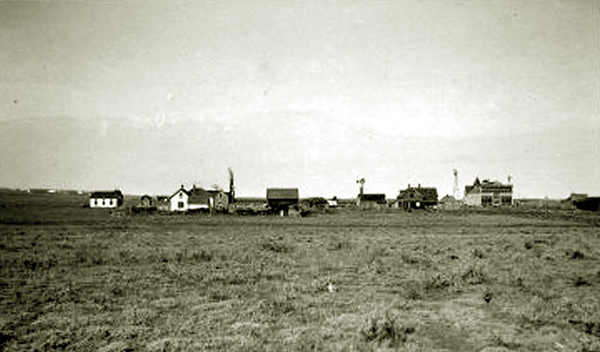
Distant view Manville, approx 1910. Photo by the Reverend
W. B. D. Gray and Annette Gray.
To the left of the Garage is the Economy Store. The Economy Store was started in 1914 by Hans Gautschi.
Gautschi arrived in Lusk in 1905 to work as an engineer for copper mines at Rawhide Buttes and Muskrat Canyon. The last
effort at copper mining was in 1912 and 1913 when the Michigan Mine in Muskrat Canyon south of Lusk was opened. It soon played out.
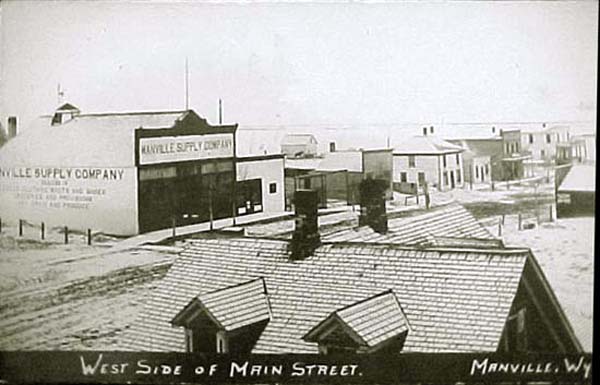
Manville, approx. 1912.
The Manville Supply Co. was owned by Spaugh and Harry Barton Card (1861-1947). The two also published Keeline Couier and
the Jireh Record. As noted on subsequent pages Keeline and Jireh further, to the west, are now ghost towns.
The illegal fencing of open range did not go unnoticed. In 1898, the State Engineer, Elwood Mead, published in his report to
the Governor, p. 128, a letter he had received denouncing Spaugh as a autocrat:
"We have in this locality, as a precedent, the Spaugh and Hord tract of State land, at present
all controlled by Mr. A. A. Spaugh; lying in one solid body of many thousand acres with
many small springs and streams, with beautiful places for homes and small stockmen, all of
whom have been "frozen out and cleaned up," as Mr. Spaugh expresses it; extending north and
south a distance of fifteen or twenty miles and more than one-half that distance north and
south, without a road or cross-road cutting through it. Notices are posted warning stockmen and
settlers from camping or driving through the premises. Mr. Spaugh and others owning or
controlling such tracts can drive or feed their stock where they please over the puiblic
range, lock their gates, and declare themselves autocrats. In the place of one man living on
this tract of land, running foreign stock to suit his own convenience, we might have twenty
good families with homes and small bunches of stock, good citizens and tax-payers.
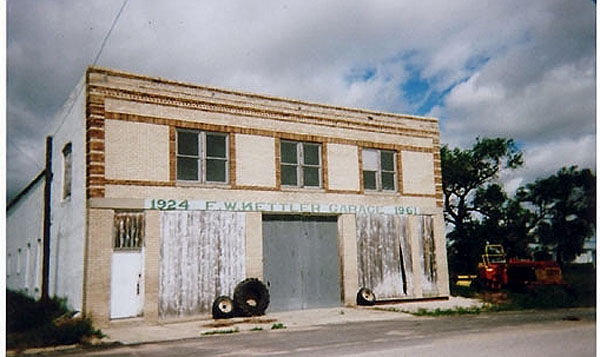
F. W. Kettler's Garage, Manville, 2005. Photo by
Geoff Dobson.
Frederick William Karl Kettler (1888-1959) was originally from William Penn, Texas. Across the
street from the garage stands the old Bank of Manville, deserted and forelorn, some windows boarded up,
others broken out with curtains blowing in
the wind.
In 1901, Spaugh was indicted for enclosing 225,000 acres of publicly owned open range near Manville. He was convicted by A federal
trial jury. Although, the law required the fencing to be removed in five days, the federal judge gave Spaugh thirty days to remove the fencing on the basis that if he
did so, he would go light on the sentencing. The fencing was removed and Spaugh was fined $50.00 and sentenced to
one day in jail. Notwithstanding his day in jail, Spaugh continued to expand his operations. In 1902, he bought out the Blain Brothers
sheep operation, The Spaugh-Baker Sheep Company eventually ran some thirty thousand head of sheep.
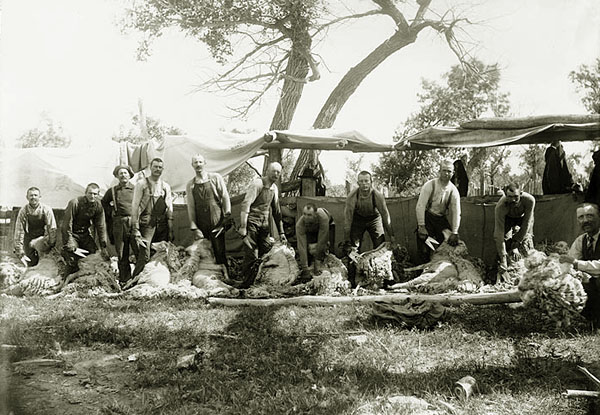
Sheep Shearing Near Lance Creek, 1901.
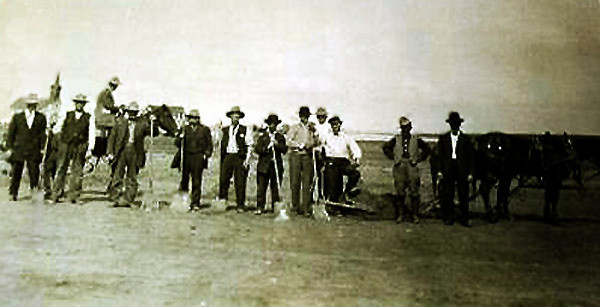
Laying out baseball field, Manville, 1912.
As earlier discussed, the concept of "dry farming" began to be promoted resulting in the breakup of many
large reanches in Niobrara County.
It was difficult or indeed impossible for an adequate living to be made from dry farming on 160 acres.
Thus, in 1909 Congress passed the "Enlarged Hometead Act of 1909." This resulted in a minor population boom in what was then
eastern Converse County. This was one of the factors taken into consideration in the formation of
Niobrara County. Additionally from 1914 to 1920, an oil boom hit the Manville area. Spaugh, along with his brother William Plum "Billy" Spaugh
and Thomas Blair of Colorado, organized the
Sunset Oil Co. capitalized at $5,000,000. Additionally the Spaughs organized the Midland Oil Co. William. P. Spaugh (1876-1965) was mayor of Manville. The company held some 10,000 acres of oil leases in the Lance Creek area and
in the "Big Muddy." By 1922, the companies had
drilled three wells.

Fourth of July Parade, Manville, 1919.
Manville and the Spaughs were on a roll. Following the census of 1910, the town had been incorporated as a municipality.
In 1910, the town had a population of 133. 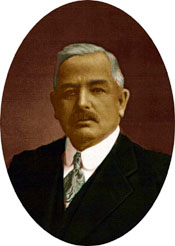 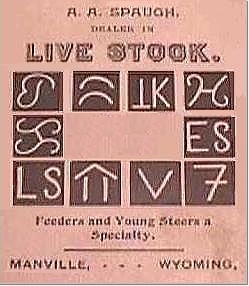 Addison Augustus Spaugh Addison Augustus Spaugh
President, Citizens National Bank,
Cheyenne.
By 1918 the town had a waterworks, hotel, telephone exchange and a grain elevator. In 1918, the town council
authorized the construction of concrete sidewalks and crosswalks. H. B. Card, president of the bank, purchased a new
Paige automobile. Marshal McClure began enforcing speed limits against "speed fiends" with his
stop watch. F. W. Powers, the owner of the Farmers Hotel, opened a new meatmarket.
Spaugh in 1916 and 1917 liquidated his cattle and sheep interests and began an
expansion of bank and other holdings. Spaugh reinvested the earnings from the sale of the cattle and sheep interests and organized the Bank of Keeline, the Bank of Glenrock, the First State Bank of Cheyenne, the Bankers and
Stockmen's Trust Company in Cheyenne.
and the Commercial Bank & Trust Co. in Douglas. Additionally, he became the president of the
Citizens National Bank in Cheyenne. About 1918, the Bank of Manville moved into its new bank building across the stree from Kettler's Garage.
Two oil companies maintained offices in the Bank Building. In 1920, a second bank the First National Bank of Manville was organized. The town had multiple fraternal lodges.
In May, 1920, Roosevelt Lodge Free & Accepted Masons was instituted. That fall, the Eastern Star was instituted by the
Deputy Grand Patron who flew to Manville from Cheyenne in one hour, thirty-three minutes. His areoplane
landed on the baseball field. A Woodsmen's Lodge and a Royal Neighbors Lodge were organized. The Royal
Neighbors was a fraternal order for women which provided insurance.
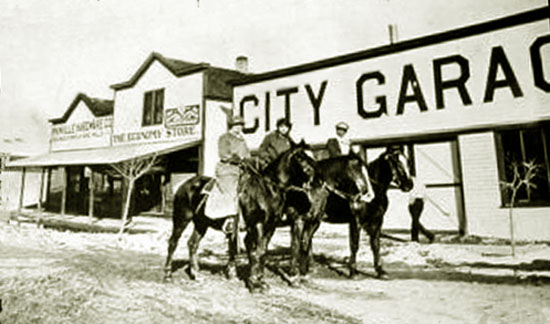
City Garage, Manville, undated.
Movies were shown in the
Dotha Theatre. The theatre also hosted boxing matches. In 1920, Ernie "Kid" Ross from Lusk bested
Omaha's "Kid" Wade in a ten-round match at the Dortha. Dances and other activities were held in Spaugh Hall. By 1920, the town reached a population of
584.Om 1922 the Bank of Manville failed and the National Bank took over its facilities. A year later on December 11, 1923 it too failed.
In 1924, Spaugh proposed instituting motor bus service from Manville to Cheyenne. His application was denied
on the basis that motor busses for a community such as Manville was regarded as "experimental."
On July 9, 1924, the First National Bank of Cheyenne failed.
One by one other banks in Wyoming fell like a row of dominoes. The Bank of Keeline closed.
By 1926, the crown jewel of Spaugh's banking empire,
The Citizens National Bank of Cheyenne located in what is now the Boyd Building, was in recievership.

Manville approx. 1916.
The boom ended. In the period from 1920 to 1930 more than half
of the banks in the state had closed. In 1929, Spaugh filed for bankruptcy. By 1930, the
town's population had plummeted to 201. The Economy Store closed and Hans Gautschi moved back to Lusk where
he operated a Standard Station. Billy Spaugh moved to California. There he was again involved in the petroleum
business and drilled a well at the southern edge of the Mahala Oil Field. It was a dry hole. In California, Billy took pride in
his cowboy past. In 1931, Spaugh with cowboy movie director Harry Arthur Gant, former Manville Town Marshal Neal Hart and with other
cowboys organized the "Chuck Wagon Trailers." The C.W.T was primarily composed primarily of
movie extras and stunt men who had actually worked on the Open Range in the 19th Century. Before moving to Hollywood,
Gant had worked for the Two Bar and for the C Y. and had appeared in Cheyenne Frontier Days. The Chuck Wagon Trailers was initially formed
in 1931 at the Lasky Famous Players Ranch used for filming western movies.
Billy Spaugh, Gant and Hart was on the first board of directors along with movie director Harry Arthur Gant and western movie star and director Neal Hart(1870-1949).
Gant, the son of a Denver Livery Stable owner, had become a
cowboy at about age 12. Later Gant became a rodeo cowboy, produced Wild West shows and arranged with the Army to provide horses
and cavalrymen for the Edison film "The Charge of the Light Brigade" filmed outside of
Cheyenne. At the time, the only cavalrymen available at D. A. Russell was a black regiment resulting in most of the British
cavalry being dark complected.
Hart served four years as foreman of the 77 and as a
cowboy for Tom Black on his Willow Creek ranch. Additionally he served for three years as Town Marshal of Manville. In 1913 Hart joined the Miller Brothers 101 Show before
moving to the lights of Hollywood.
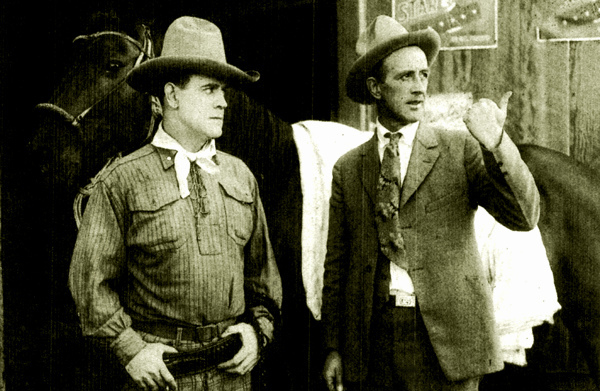
Former Manville Town Marshal Neal Hart and Harry Arthur Gant, 1919.
Initially the Chuck Wagon Trailers worked to construct a home for
elderly cowboys who had fallen on hard times. As the old cowboys began to die, the restriction was raised to
those who had ridden the range before 1910. Dues were at first $1.00, but later raised as was also the requirement of having been on the range
before 1910. By 1936 only the three cowboys from Converse and Niobrara Counties, Gant, Hart and Spaugh, remained from the first board of directors. See
Eugene [Oregon] Register-Guard, Nov. 15, 1936, p. 11 "Cow Waddies still prefer Chuckwagon Grub." See also generally Gant, Harry: "I Saw Them Ride Away." Other Wyoming
cowboys who joined the Chuck Wagon Trailers included former Governor Bob Carey and railroad train robber Bill Carlisle.
With the death of Billy Spaugh, the original founders of the Chuck Wagon Trailers were gone. The organization continues, but membership requirements have
relaxed.
In 1934 the Manville Masonic Lodge went dark and merged with Lusk's Harmony Lodge.
In 1943, Addison with his wife was living in the Shirley-Savoy Hotel in Denver. There he died. His body was brought
back to Manville for a Masonic Funeral. Billy died in 1965 in California. He too is interred at Manville along with Curt who died in 1909 following a series
of dehabilitating strokes. By 1970, the
population of Manville had fallen to 101.
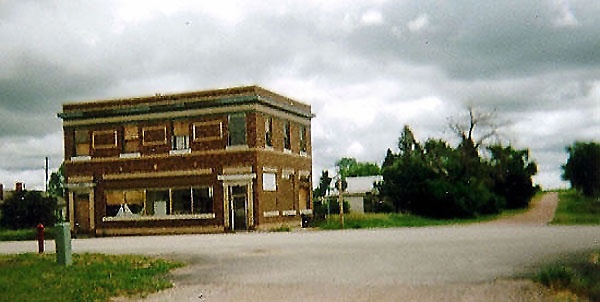
The Bank of Manville, 2005. Photo by Geoff Dobson.
The bank, founded in 1907, was originally controlled by Harry B. Card (1888-1947) as president and
Spaugh as vice-president. Card was a wool grower, and vice-president
and director Manville Supply Co. Card came west from Ohio and worked as a cowboy on a number of
ranches in the Lost Springs area. He proved up his homestead in 1893 and gradually extended his holdings.
Music this Page: "When I Bid the Prairie Goodbye," as sung by Montana Slim.
Next Page: Lost Springs.
|